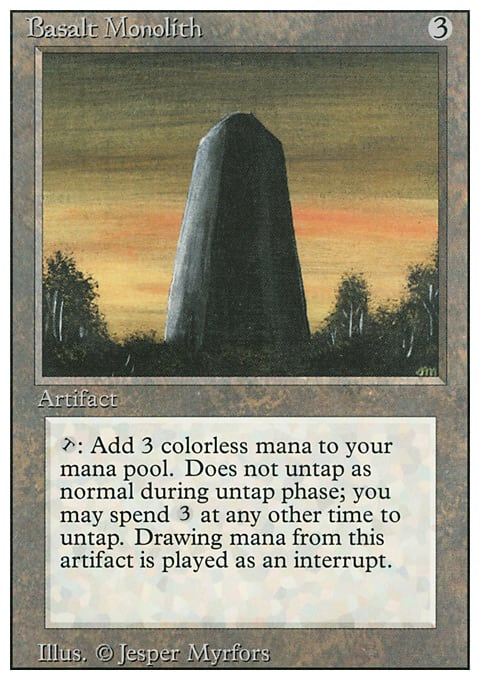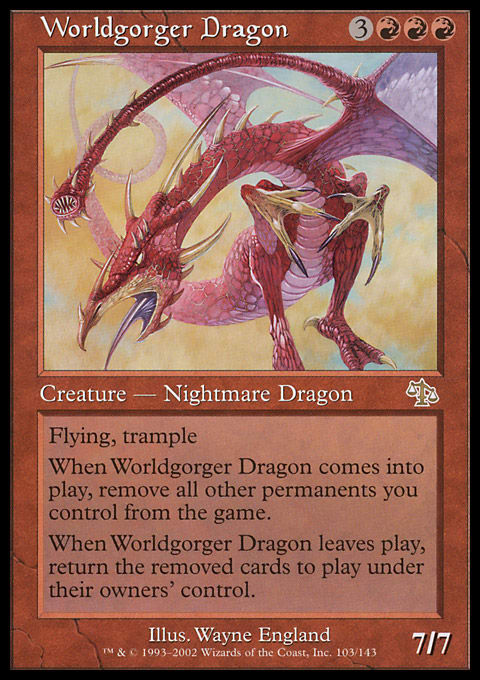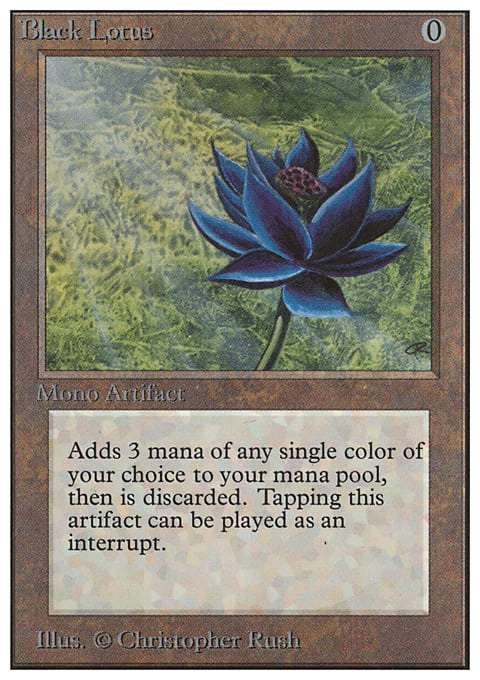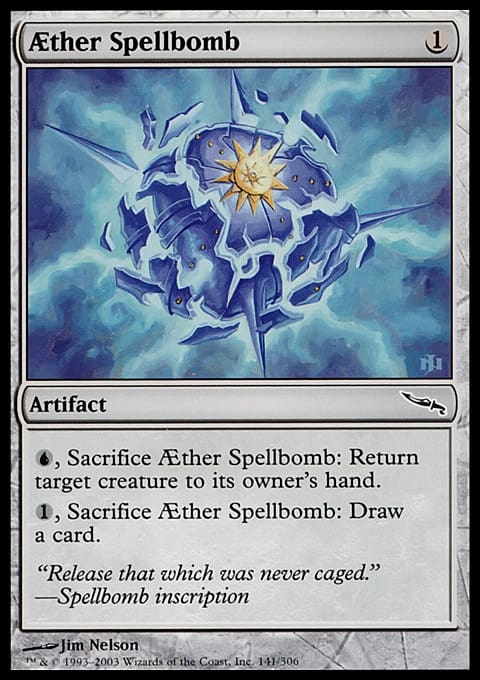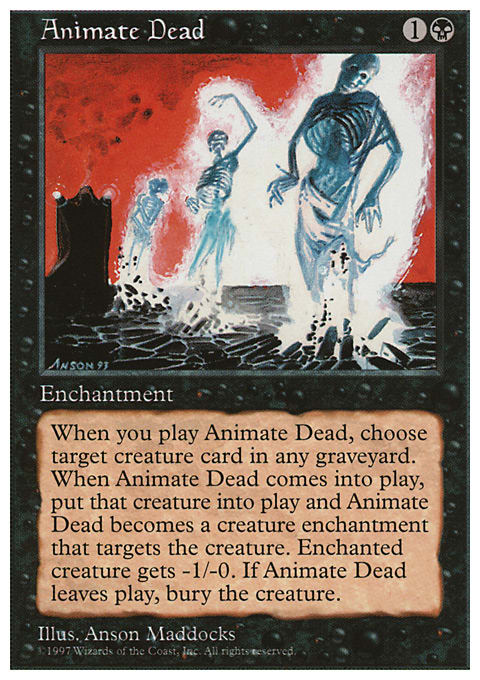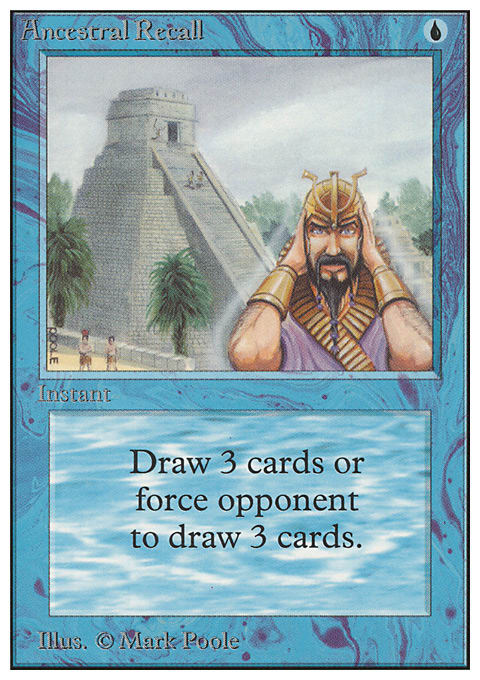Infinity is a pretty neat concept when it comes to Magic: The Gathering. As part of typical hyperbole, players use it for really large, but totally comprehensible numbers: “I attacked with the team and dealt infinity with Goblin Piledrivers,” “I literally had infinite mana while my opponent was stuck on 2,” “She had infinite Brainstorms! I just couldn’t keep up.” Really, these numbers were something like 14, 6, and (obviously) four.
In fact, in most Magic rules situations, infinite is an improper term. When a player describes an infinite combo, for example, he or she is really talking about an unbounded one. You can’t actually make infinite mana with Basalt Monolith and Power Artifact, but you can make a very large specific number. I like 2 million, but sometimes that doesn’t seem like enough so I say 2 billion.
You can do a lot with 2 billion mana.
Combos like this are possible in paper Magic because players are allowed to demonstrate unbounded loops to their opponents and then declare how many times they want to repeat. If the opponent wants to jump in at any point, he or she can just let you know. This used to be important when mana burn was around since the player could say, “Okay, after you make your first 100 mana, I’m going to play this disruption spell,” hoping you weren’t prepared and would have to end the phase with 100 mana in your pool and die. Otherwise, you would make a very large specific number of something and usually win the game.
On Magic Online, of course, making a very large specific number of something takes a very large specific number of clicks, and in a format with chess-clock timers, that won’t always be doable. Instead of finishing off your opponent, you instead lose to yourself. As a result, there are decks that aren’t truly playable online. MTGO can replicate much of the Magic experience, and it allows sanctioned Vintage to be played affordably without regard to player location, but it’s not always an accurate representation of Vintage as it’s played in real life.
Because its card pool is so vast, Vintage allows several combos that would be infinite. Not all of them fit neatly into a realistic decklist—one that’s compact, efficient, lethal, and contains cards that are at least somewhat reasonable on their own—but I’ve seen plenty of them at one time or another. I remember one player in particular who filled his deck with as many combos and tutors as he could, on the not unreasonable chance that the cards would come together in winning groups. He was able to set up Grim Monolith with Power Artifact on turn two and win with a massive Braingeyser on turn three—not bad!
Anyway, there are three combos that I would suggest are parts of playable Vintage decks that can’t be played online: Bomberman (Auriok Salvagers with Black Lotus), Dragon (Worldgorger Dragon with Animate Dead), and Metalworker with Staff of Domination.
Burning out His Fuse up There Alone
Auriok Salvagers appeared in Vintage as a combo piece with Black Lotus in June 2004 soon after its printing. The two cards pair up to make a very large amount of mana:
- Sacrifice Black Lotus to make 3 white mana.
- Return Lotus with Auriok Salvagers, netting 1 white mana.
- Replay Lotus and repeat to make a lot of white mana. Once you have enough white mana, you can start repeating to make other colors, too.
From there, with several million mana, the easiest way to win was to follow a similar process using Pyrite Spellbomb. The Spellbomb could be used similarly to draw cards.
- Sacrifice Pyrite Spellbomb to deal 2 damage to your opponent (or draw a card).
- Return Spellbomb with Auriok Salvagers.
- Replay Spellbomb and repeat until your opponent has died (or you have drawn most of your deck).
This combo, using Lion's Eye Diamond over Black Lotus, has also been played in Legacy, where it was known as “Golden Grahams.” I don’t know why.
Today, there are three versions of Bomberman that show up with some regularity: W/U with Aether Spellbomb and a rock-solid mana base against Wastelands; W/U/r with Pyrite Spellbomb and Ingot Chewers and Dack Faydens against artifacts; and W/U/b with Nihil Spellbomb, tutors, and Dark Confidants. My personal favorite is W/U Bomberman; below is the list I have together.
W/U Bomberman ? Vintage | Nat Moes
- Creatures (11)
- 1 Aven Mindcensor
- 1 Containment Priest
- 2 Snapcaster Mage
- 3 Auriok Salvagers
- 4 Trinket Mage
- Spells (34)
- 1 Ancestral Recall
- 1 Dig Through Time
- 1 Disenchant
- 2 Spell Pierce
- 2 Swords to Plowshares
- 4 Force of Will
- 4 Mana Drain
- 4 Thirst for Knowledge
- 1 Time Walk
- 1 Treasure Cruise
- 1 Aether Spellbomb
- 1 Black Lotus
- 1 Engineered Explosives
- 1 Mana Crypt
- 1 Mox Emerald
- 1 Mox Jet
- 1 Mox Pearl
- 1 Mox Ruby
- 1 Mox Sapphire
- 1 Pithing Needle
- 1 Sensei's Divining Top
- 1 Sol Ring
- 1 Tormod's Crypt
- Lands (15)
- 1 Plains
- 2 Island
- 1 Library of Alexandria
- 2 Scalding Tarn
- 3 Tundra
- 4 Flooded Strand
- 1 Snow-Covered Island
- 1 Tolarian Academy
- Sideboard (15)
- 1 Engineered Explosives
- 2 Mindbreak Trap
- 2 Kataki, War's Wage
- 1 Umezawa's Jitte
- 1 Sword of Fire and Ice
- 2 Swords to Plowshares
- 2 Disenchant
- 3 Relic of Progenitus
- 1 Grafdigger's Cage
The list switches roles well between hard control featuring Trinket Mages to find answers for many problem opponents (like Tormod's Crypt and Pithing Needle winning Game 1 against Dredge), aggro with the Trinket Mage into Black Lotus for a second Trinket Mage opener, and combo with Auriok Salvagers (with Trinket Mage finding all the relevant artifact parts). Obviously, Trinket Mage is an important part of the list, but the deck also works well with four-of Thirst for Knowledge. It’s also surprising how few decks play good answers to Salvagers, a hard-cast, 4-drop creature with 4 toughness.
Winning with the Bomberman combo into Aether Spellbomb usually involves drawing most of your deck; destroying your opponent’s game with Engineered Explosives, Tormod's Crypt, and Pithing Needle; playing all your creatures; and Time Walking with a handful of counters.
The Jeskai and Esper versions of Bomberman build on this concept but play a little differently. As I mentioned, red offers more options against Mishra's Workshop decks and creatures, and black trades out some of the control spells for more tutors, so it can be more aggressive at finding the combo and win with Pyrite Spellbomb. Also, any version can also play Monastery Mentor as an additional win condition, one that enjoys having a lot of artifacts played again from the graveyard.
Brian Kelly’s first-place deck from the Vintage Championship was notable for several novel card choices and its pairing of Oath of Druids and the Bomberman combo. It wasn’t the first deck to do that, but the build is uncommon, and it continues to be unseen, as players never really picked up the list after its crowning performance. I edited the list below to make it legal today, dropping one Dig Through Time and adding one Treasure Cruise.
Salvagers/Dromoka Oath ? Vintage | Brian Kelly
- Creatures (3)
- 1 Auriok Salvagers
- 1 Dragonlord Dromoka
- 1 Griselbrand
- Planeswalkers (4)
- 2 Dack Fayden
- 2 Jace, the Mind Sculptor
- Spells (36)
- 1 Ancestral Recall
- 1 Ancient Grudge
- 1 Brainstorm
- 1 Dig Through Time
- 1 Repeal
- 2 Flusterstorm
- 2 Mental Misstep
- 3 Force of Will
- 1 Ponder
- 1 Time Walk
- 1 Treasure Cruise
- 3 Gitaxian Probe
- 1 Sylvan Library
- 4 Oath of Druids
- 1 Black Lotus
- 1 Engineered Explosives
- 1 Mana Crypt
- 1 Mox Emerald
- 1 Mox Jet
- 1 Mox Pearl
- 1 Mox Ruby
- 1 Mox Sapphire
- 1 Sol Ring
- 2 Pyrite Spellbomb
- 2 Sensei's Divining Top
- Lands (17)
- 1 Island
- 1 Library of Alexandria
- 1 Tropical Island
- 1 Tundra
- 1 Volcanic Island
- 2 Flooded Strand
- 2 Polluted Delta
- 3 Mana Confluence
- 4 Forbidden Orchard
- 1 Tolarian Academy
- Sideboard (15)
- 1 Ancient Grudge
- 1 Magus of the Moat
- 1 Mental Misstep
- 2 Nature's Claim
- 2 Nihil Spellbomb
- 1 Sphinx of the Steel Wind
- 2 Steel Sabotage
- 2 Sudden Shock
- 3 Tormod's Crypt
The deck might look to be a hodgepodge in a format in which most decks are trying to play the same game every time, but an obvious amount of work was put into designing it, and the Bomberman combo is an integral part of how things play out.
Oath of Druids sets up the Bomberman combo because an Oath activation that finds Salvagers can also have dumped Lotus and Spellbomb in the graveyard. More importantly, Salvagers isn’t difficult to hard-cast if your opponent brings in Grafdigger's Cage, leaving it on top of your library, and there were a lot of Cages in Philadelphia for last year’s Champs.
Dragon Eat World
Bomberman takes a lot of combo repetitions to win, but it’s fairly straightforward. There are plenty of sorcery-speed opportunities to pause and figure things out or explain the process to your opponent. The Worldgorger Dragon combo, on the other hand, sort of goes like a rocket. There’s only one spell to counter, and the rest can only be interacted with at instant speed.
- Animate Dead (or Dance of the Dead or Necromancy) targets Worldgorger Dragon in the graveyard.
- Worldgorger Dragon enters the battlefield, removing all your other permanents, including the Animate Dead and all your lands.
- No longer enchanted, Worldgorger Dragon is sacrificed.
- Worldgorger Dragon leaves the battlefield, returning all your other permanents, including the Animate Dead and all your lands.
- At this point, you can tap lands and float mana or use Bazaar of Baghdad. Then return to the first step.
Without an instant-speed win or another creature to enchant and break the loop, this just keeps going. Bazaar of Baghdad is often used within the loop to put another creature in the graveyard. In the past, this was Shivan Hellkite, Ambassador Laquatus, and more recently Oona, Queen of the Fae. Any of these creatures allow you to dump mana and win through one method or another, but they’re not great on their own.
When Tasigur, the Golden Fang, was printed in Fate Reforged, it gave a new option to win with a large amount of mana as well as being a versatile 4/5 threat on its own. Jace, Vryn's Prodigy complemented Bazaar of Baghdad as a way to draw and discard Worldgorger Dragon and take advantage of other graveyard tricks like delve.
I’ll link J.R. Goldberg’s report from Eternal Weekend. The updated list I received from him is below.
Dragon Combo ? Vintage | J.R. Goldberg
- Creatures (7)
- 3 Worldgorger Dragon
- 1 Tasigur, the Golden Fang
- 3 Jace, Vryn's Prodigy
- Spells (35)
- 1 Ancestral Recall
- 1 Dig Through Time
- 1 Hurkyl's Recall
- 1 Mental Misstep
- 1 Vampiric Tutor
- 2 Flusterstorm
- 2 Intuition
- 4 Force of Will
- 1 Deep Analysis
- 1 Demonic Tutor
- 1 Time Walk
- 1 Timetwister
- 1 Treasure Cruise
- 2 Gitaxian Probe
- 2 Thoughtseize
- 1 Dance of the Dead
- 1 Necromancy
- 3 Animate Dead
- 1 Black Lotus
- 1 Mana Crypt
- 1 Mox Emerald
- 1 Mox Jet
- 1 Mox Pearl
- 1 Mox Ruby
- 1 Mox Sapphire
- 1 Sol Ring
- Lands (18)
- 1 Swamp
- 2 Island
- 1 Tundra
- 3 Polluted Delta
- 3 Underground Sea
- 4 Bazaar of Baghdad
- 4 Flooded Strand
- Sideboard (15)
- 2 Cavern of Souls
- 1 Plains
- 1 Tasigur, the Golden Fang
- 2 Monastery Mentor
- 1 Auriok Salvagers
- 1 Nihil Spellbomb
- 2 Steel Sabotage
- 1 Hurkyl's Recall
- 1 Serenity
- 3 Containment Priest
After reanimating Dragon to make mana, target Tasigur with the Animate Dead to break the loop. Then you can start a new loop.
- Activate Tasigur’s ability repeatedly to “draw” your library. (You will put your library into your graveyard two cards at a time, and your opponent will eventually be forced to put all nonland cards into your hand. At this point, your hand will have all your counterspells, and you will still have a very large, specific number of mana.)
- Target your opponent with Ancestral Recall.
- Activate Tasigur’s ability to return Ancestral Recall to your hand.
- Repeat from the second step to force your opponent to draw his or her library.
Remember: You still have all your counterspells. If your opponent tries to stop you at this point, you can counter multiple times and return those cards to your hand in the same way as returning Ancestral Recall.
Dragon Combo is similar to Oath of Druids in that it really needs to resolve only one 2-drop spell to win. It’s easy enough to sneak an Animate Dead through a blue opponent’s counter wall using your own counters and Thoughtseize, which you can replay with a flipped Jace if necessary. It works similarly against Mishra's Workshop decks, against which, if you can start the combo, you can make enough mana to play through any number of Sphere of Resistance effects.
Welcome to the Machine
And for those who think combos like these are only for the blue players, there are Metalworker and Staff of Domination in Workshops. Here, Staff has enough abilities (including that of untapping itself) to win on its own with enough mana; Metalworker is simply the gasoline.
- Tap Metalworker and reveal at least three artifacts, producing 6 mana.
- Tap Staff of Domination and pay 3 to untap Metalworker.
- Pay 1 to untap Staff of Domination.
- At this point, you’ve netted 2 mana and can return to the first step.
Once you’ve gone through this loop a few hundred times, you’ll have enough mana to use Staff similarly to draw your deck, gain life, tap all your opponent’s creatures, and untap all of yours. You can also play most of what you drew, potentially locking your opponent under Sphere of Resistance effects, filling the board with giant robots, or even ending the game with enough Triskelions or a Blightsteel Colossus and Lightning Greaves. (As should be obvious by now, if you reach the point of having all the mana and cards, you should be able to finish the game with some certainty.)
Snoop Shops ? Vintage | Mark Trogdon
- Creatures (24)
- 2 Arcbound Ravager
- 3 Phyrexian Metamorph
- 3 Triskelion
- 4 Hangarback Walker
- 4 Lodestone Golem
- 4 Metalworker
- 4 Phyrexian Revoker
- Spells (17)
- 1 Black Lotus
- 1 Mana Crypt
- 1 Mox Emerald
- 1 Mox Jet
- 1 Mox Pearl
- 1 Mox Ruby
- 1 Mox Sapphire
- 1 Sol Ring
- 2 Relic of Progenitus
- 3 Staff of Domination
- 4 Sphere of Resistance
- Lands (19)
- 1 Strip Mine
- 2 Ghost Quarter
- 3 Ancient Tomb
- 4 Mishra's Factory
- 4 Mishra's Workshop
- 4 Wasteland
- 1 Tolarian Academy
- Sideboard (15)
- 1 Crucible of Worlds
- 2 Blasting Station
- 2 Spawning Pit
- 3 Thorn of Amethyst
- 2 Relic of Progenitus
- 4 Ravenous Trap
- 1 Triskelion
Mark Trogdon has been playing Workshops in Vintage for years and frequently finds ways to win without taking the typical line of prison aggro. This list is mostly aggressive creatures, including Arcbound Ravager and Triskelion, which do fun things together with +1/+1 counters. The highlight here is the introduction of Metalworker and Staff. In many games, Metalworker will just be powering out Trikes and big Hangarback Walkers and let you use Wasteland and Ghost Quarter frequently, but it will sometimes pair with Staff and just win.
Mark’s deck also features a lot of tricky cards against the format. Relic of Progenitus, for example, can win against Dredge (or Dragon) but also has great applications against Dark Petition, where it can stop the spell mastery. For a while, he was playing four Relics in the main deck, I know. The Blasting Stations in the sideboard work against Oath of Druids, allowing you to get rid of Forbidden Orchard tokens and deal damage without using your own creatures.
Having Vintage playable on Magic Online is pretty great, but it can’t capture everything about Vintage. Decks like these, with “infinite” combos, are a lot of fun to play, especially because you sometimes play against an opponent who’s never seen them before. (It’s kind of satisfying to explain the process to someone, in my opinion anyway—learning opportunities!) To get in on them, you’ll just have to play Vintage yourself!
Thanks for reading!
Nat Moes













